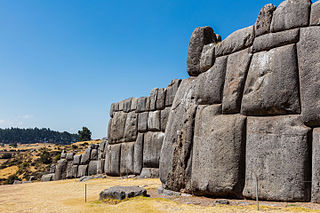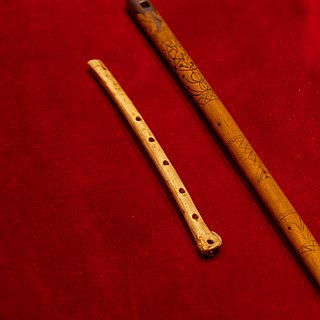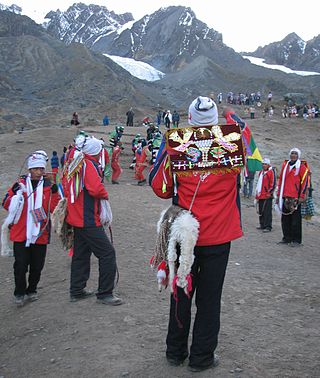Related Research Articles

Quechua, also called Runasimi in Southern Quechua, is an indigenous language family that originated in central Peru and thereafter spread to other countries of the Andes. Derived from a common ancestral "Proto-Quechua" language, it is today the most widely spoken pre-Columbian language family of the Americas, with the number of speakers estimated at 8–10 million speakers in 2004, and just under 7 million from the most recent census data available up to 2011. Approximately 13.9% of Peruvians speak a Quechua language.

Cusco or Cuzco is a city in southeastern Peru, near the Sacred Valley of the Andes mountain range and the Huatanay river. It is the capital of the eponymous province and department. The city is the seventh most populous in Peru; in 2017, it had a population of 428,450. Its elevation is around 3,400 m (11,200 ft).

Apurímac is a department in southern-central Peru. It is bordered on the east by the Department of Cusco, on the west by the Department of Ayacucho, and on the south by the Arequipa and Ayacucho departments. The department's name originates from the Quechua language and means "where the gods speak" in reference to the many mountains of the region that seem to be talking to each other.

Cusco, also spelled Cuzco, is a department and region in Peru and is the fourth largest department in the country, after Madre de Dios, Ucayali, and Loreto. It borders the departments of Ucayali on the north; Madre de Dios and Puno on the east; Arequipa on the south; and Apurímac, Ayacucho and Junín on the west. Its capital is Cusco, the historical capital of the Inca Empire.

Huánuco is a city in central Peru. It had a population of 196,627 as of 2017 and in 2015 it had a population of 175,068. It is the capital of the Huánuco Region and the Huánuco District. It is the seat of the diocese of Huánuco. The metropolitan city of Huanuco is 170,000 hab. It has three districts, Huanuco (head), Amarilis, and Pillco Marca. In this city, the Higueras river meets the Huallaga river, one of the largest rivers in the country.

Quechua people or Quichua people may refer to any of the indigenous peoples of South America who speak the Quechua languages, which originated among the Indigenous people of Peru. Although most Quechua speakers are native to Peru, there are some significant populations in Ecuador, Bolivia, Chile, Colombia, and Argentina.
Cusco–Collao or Qusqu–Qullaw (Quechua) is a collective term used for Quechua dialects that have aspirated and ejective plosives, apparently borrowed from Aymaran languages. They include Cusco Quechua, Puno Quechua, North Bolivian Quechua, and South Bolivian Quechua. Together with Ayacucho Quechua, which is mutually intelligible, they form the Southern Quechua language.

The Inti Raymi is a traditional religious ceremony of the Inca Empire in honor of the god Inti, the most venerated deity in Inca religion. It was the celebration of the winter solstice^ – the shortest day of the year in terms of the time between sunrise and sunset – and the Inca New Year, when the hours of light would begin to lengthen again. Celebrated on June 24, the Inti Raymi was the most important festival of the Inca Empire, as described by Inca Garcilaso de la Vega, and took place in the Haukaypata, the main square of Cusco.

A pinkillu, pinkuyllu or pinqullu is a flute found throughout the Andes, used primarily in Argentina northwest, Bolivia, Chile, Ecuador and Peru. It is usually played with one hand, leaving the other one free to accompany oneself on a drum like the tinya. It is used in a variety of public festivals and other kinds of communal ceremonies.

While the Peruvian film industry has not been nearly as prolific as that of some other Latin American countries, such as Mexico or Argentina, some Peruvian movies produced enjoyed regional success. Historically, the cinema of Peru began in Iquitos in 1932 by Antonio Wong Rengifo because of the rubber boom and the intense arrival of foreigners with technology to the city, and thus continued an extensive, unique filmography, with a different style than the films made in the capital, Lima.
María Cleofé Sumire de Conde is a Peruvian politician. She belongs to the Union for Peru party and was a Congresswoman representing Cusco for the period 2006-2011 and was a candidate for the 2005 Nobel Peace Prize.

Hilaria Supa Huamán is a Peruvian politician, human rights activist, and an active member of several Indigenous women's organizations in Peru and around the world. She was a Congresswoman representing Cusco from 2006-2011, as a member of Ollanta Humala's Partido Nacionalista Peruano party.

Dance in Peru is an art form primarily of native origin. There are also dances that are related to agricultural work, hunting and war. In Peru dancing bears an important cultural significance. Some choreographies show certain Christian influence.

Tambomachay is an archaeological site associated with the Inca Empire, located near Cusco, Peru. An alternate Spanish name is El Baño del Inca.

Patallacta, Llactapata or Q'ente Marka is an archaeological site in Peru located in the Cusco Region, Urubamba Province, Machupicchu District. It is situated southeast of the site Machu Picchu, at the confluence of the rivers Cusichaca and Vilcanota on a mountain named Patallacta.

Jolljepunco, Colquepunco or Sasahui (sasawi) local name for Leucheria daucifolia, -ni an Aymara suffix to indicate ownership, "the one with the sasawi plant", Hispanicized Sasahuini) is a mountain in the Andes of Peru and the name of a lake near the peak. The mountain is about 5,522 metres (18,117 ft) high. It is situated in the northern extensions of the Vilcanota mountain range in the Cusco Region, Quispicanchi Province, in the districts Ccarhuayo and Ocongate and in the Paucartambo Province, Kosñipata District. Jolljepunco lies northwest of the lake Singrenacocha, southeast of Minasnioc. The lake named Jolljepunco is situated south of the mountain at 13°32′04″S71°12′29″W.
Choquesafra or Choquezafra is a 5,152-metre-high (16,903 ft) mountain in the Vilcabamba mountain range in the Andes of Peru. It is located in the Cusco Region, La Convención Province, on the border of the districts of Inkawasi and Vilcabamba. Choquesafra lies west of the Panta group and south of a river named Rancahuayco. The Huajchay River originates northwest of the mountain. It flows to the southwest as a right affluent of the Apurímac River.
Ayamachay is an archaeological site with rock paintings in Peru. It is situated in the Cusco Region, Canchis Province, Combapata District, above the left bank of the Salqa or Salcca river near the village of Oroscocha or Oroscocha. The paintings are predominantly white and show abstract or geometrical figures.
Kuntur Wachana is a Peruvian docudrama directed by Federico García Hurtado. It was released in 1977. Kuntur Wachana won the FIPRESCI international critics' prize at the 10th Moscow International Film Festival.
Kukuli Velarde is a Peruvian artist based in Philadelphia, Pennsylvania. She specializes in painting and ceramic sculptures made out of clay and terra-cotta. Velarde focuses on the themes of gender and the repercussions of colonization on Latin American history, with a particular interest in Peru. Her ceramics consist of unusual body positions, childlike faces, and works that have been molded from her own face as well.
References
- ↑ Diccionario Quechua - Español - Quechua, Academía Mayor de la Lengua Quechua, Gobierno Regional Cusco, Cusco 2005 (Quechua-Spanish dictionary)
- ↑ "2nd Moscow International Film Festival (1961)". MIFF. Archived from the original on 16 January 2013. Retrieved 10 November 2012.
- ↑ "Film Kukuli (Cuzco-Peru)". Latinos in London. Retrieved 10 November 2012.